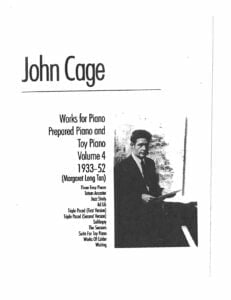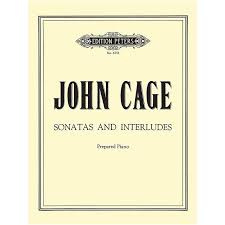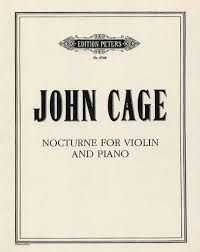Table of Contents
John Cage – Dream sheet music, Noten, partitura, spartiti, partition, 楽譜
Come join us now, and enjoy playing your beloved music and browse through great scores of every level and styles!
Can’t find the songbook you’re looking for? Please, email us at: sheetmusiclibrarypdf@gmail.com We’d like to help you!

Best Sheet Music download from our Library.

Please, subscribe to our Library.
If you are already a subscriber, please, check our NEW SCORES’ page every month for new sheet music. THANK YOU!
Browse in the Library:
Or browse in the categories menus & download the Library Catalog PDF:
The Sound of Silence: John Cage and the Radical Redefinition of Music
John Cage (1912-1992) wasn’t just a composer; he was a seismic force, a philosophical provocateur who fundamentally reshaped our understanding of what music is. More than any other figure in the 20th century, Cage challenged the bedrock assumptions of composition, performance, listening, and the very nature of sound itself. His innovations, often controversial and always thought-provoking, continue to resonate through contemporary music, art, and philosophy.

Breaking the Mold: Early Explorations
Cage’s journey began conventionally enough with studies in composition, including a significant period with Arnold Schoenberg. However, Cage quickly chafed against traditional harmony and structure. He became fascinated with rhythm as the primary organizing principle and, crucially, with percussion as the orchestra of the future. His early works, like First Construction (in Metal) (1939), explored complex rhythmic patterns and the vast sonic palette of non-pitched instruments – brake drums, thunder sheets, and found objects alongside conventional drums and gongs.
The Prepared Piano: An Orchestra in a Box

Faced with the practical challenge of composing percussive dance music for a small space lacking a full percussion ensemble, Cage made his first major practical innovation: the prepared piano. By inserting bolts, screws, rubber erasers, and other objects between the strings of a grand piano, he transformed it into a miniature percussion orchestra. Each preparation dampened, muted, or altered the timbre and pitch of the string, creating a dazzling array of plinks, thuds, rattles, and gongs. Masterpieces like Sonatas and Interludes (1946-48) showcase this invention, creating ethereal, gamelan-like textures that were entirely new to Western music.
Silence Speaks Volumes: 4’33”

Cage’s most famous, and arguably most radical, work is 4’33” (1952). Performed by any instrument or combination of instruments, the “music” consists of the performer sitting in silence for four minutes and thirty-three seconds, divided into three movements. This wasn’t a joke, but a profound statement. Inspired by his encounter with Zen Buddhism and the white paintings of Robert Rauschenberg, Cage demonstrated that:
- Silence doesn’t exist: The “silence” is filled with the ambient sounds of the environment – shuffling feet, coughs, rain, traffic, the listener’s own breath and heartbeat. These sounds become the music.
- The role of the composer shifts: Cage relinquished control, framing the context (the time period, the performance space) rather than dictating specific pitches or rhythms.
- The listener is central: The audience’s perception and the sounds they notice create the unique musical experience each time.
4’33” forced a fundamental question: If music is organized sound, who does the organizing? Cage suggested it could be the environment, chance, or the listener’s own attention.
Chance Takes the Wheel: Indeterminacy
Following 4’33”, Cage embraced indeterminacy (or “aleatoric” music) wholeheartedly. He sought to remove his own ego, tastes, and intentions from the compositional process. To achieve this, he employed various chance operations, most famously the ancient Chinese I Ching (Book of Changes), using coin tosses to determine musical parameters:
- Pitches: Which notes to use.
- Durations: How long they last.
- Timbre: How they sound.
- Structure: The order of events.
Works like Music of Changes (1951 – for piano, using the I Ching), Imaginary Landscape No. 4 (1951 – for 12 radios, where the tuning and volume are determined by chance), and the series of Variations pieces involved complex charts and procedures where the performer made decisions based on Cage’s chance-derived instructions, often resulting in vastly different performances each time. The score became less a definitive map and more a set of possibilities.
Beyond the Score: Graphic Notation and Extended Techniques
To communicate his indeterminate ideas, Cage often moved beyond traditional musical notation. He pioneered graphic notation, using visual symbols, shapes, and spatial arrangements on paper to suggest actions, densities, durations, or textures without specifying exact pitches or rhythms. Pieces like Fontana Mix (1958) used transparent sheets with points and lines that could be overlaid in countless ways.
He also encouraged performers to explore extended techniques – unconventional ways of playing instruments (scratching the body of a cello, blowing air through a flute without producing a pitch) – further expanding the sonic vocabulary available to composers.
Legacy: The Cagean Universe
John Cage’s impact is immeasurable and pervasive:
- Expanded Sonic Palette: He legitimized all sound as potential musical material – noise, silence, environmental sounds, electronic sounds.
- Redefined Composition: Composition became as much about creating processes, frameworks, and concepts as about writing specific notes.
- Elevated Listening: He taught us to listen deeply to the world around us, finding music in the everyday.
- Blurred Boundaries: His collaborations with choreographer Merce Cunningham and artists like Rauschenberg broke down barriers between music, dance, visual art, and theater.
- Influence: He directly inspired movements like Fluxus, Minimalism (through his emphasis on duration and process), and electronic music. Composers from Stockhausen and Boulez to younger generations like John Zorn and countless experimental artists owe him a profound debt. His ideas permeate sound art, installation art, and performance art.
John Cage: Purposeful Purposelessness
John Cage once described his work as “purposeless play,” yet it was play with profound purpose. He challenged the tyranny of the composer’s intention, the hierarchy of “musical” vs. “non-musical” sound, and the passive role of the listener. He embraced the world in all its unpredictable sonic richness, finding beauty and structure not through imposition, but through attentive listening and radical acceptance. In opening the doors to silence, chance, and the entire universe of sound, John Cage didn’t just write music; he fundamentally changed how we hear the world. As he famously stated, “I have nothing to say and I am saying it and that is poetry.” Cage’s “nothing” turned out to be an endlessly resonant, revolutionary everything.
